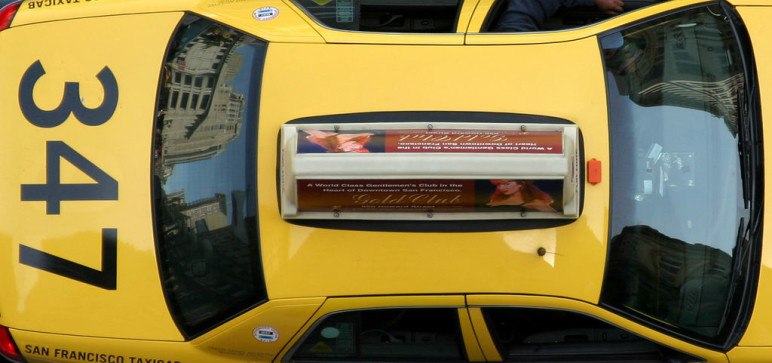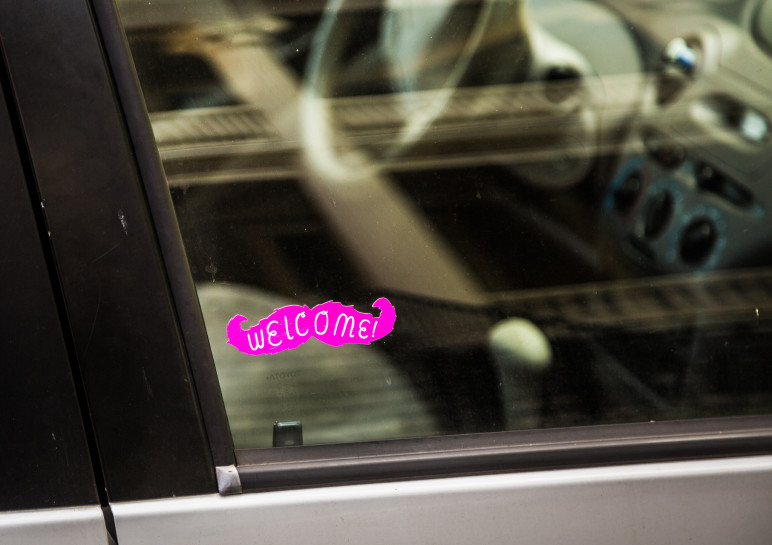Monday morning I got to work in a plain old Yellow Cab. Tuesday morning I tried Lyft, one of the new smartphone-based, on-demand “ridesharing” services that allows a regular person to turn his or her car into what operates much like a taxi with a pink mustache.
My experience with Lyft was radically better (more on that below), but not in the ways that its marketing strategy emphasizes. I wasn’t looking for my driver to be my best friend, or to feel like I was a part of a community, or to have scintillating conversations about politics before 9 a.m. I’m a mom with a poky kid, trying to get to work as quickly as possible, and I did that 34 minutes faster with Lyft.
That simple fact says a lot about the upstart—and, for now in Seattle, wholly unregulated—services that allow a customer to summon and pay for a ride from a fleet of drivers roaming the streets in their personal cars using a smartphone app. You can see on the map how far away your driver is, and that he or she is really coming. It’s much less stressful than calling a grumpy dispatcher and waiting on the side of the road, wondering if your cab will ever show up.
Lyft, along with Sidecar, uberX, and similar services, have great potential to advance urban sustainability, ease congestion, and unlock tons of wasted space in people’s personal cars. They add to the number of vehicles and options—including taxis, transit, ZipCar, Car2Go, RelayRides, and Getaround—that make it easier for people to travel around the city without having to own or drive their own personal car, and, theoretically, widen the market for all of those services.
But the new entries also fall into the class of “disruptive” businesses that take a moribund industry and reinvent it, to the point that old business models and regulatory regimes no longer make sense. Across the country, cities and states are struggling to figure out a) how to ensure that these new services are safe and reliable for consumers and b) how to avoid creating an uneven playing field for existing taxi and for-hire drivers, many of them immigrants and people of color, whose opportunities have long been constrained by local laws.
In Seattle, for instance, the taxi industry is governed by balkanized factions and complicated regulations that restrict the number of taxi and for-hire licenses, and consequently the number of available vehicles on the street. By putting a cap on the number of legal taxi licenses and a longstanding reluctance to add more licenses to the pool, Northwest cities and counties have protected existing license owners from competition, created a secondary market where licenses sell for tens or hundreds of thousands of dollars, and prevented many drivers from ever hoping to own or operate their own cabs.
[button link='{“url”:”http://www.sightline.org/2011/08/05/freeing-taxis/”,”title”:”Plentiful, affordable taxis facilitate greener urban travel. Curious how? Read more here.”}’ color=”green”]
Taxi drivers, for-hire drivers (who in some cities can pick people up by prearrangement but aren’t supposed to accept fares if they’re hailing a ride on the spot), limo drivers, and license owners each have to follow a set of city, county, state, or port requirements, which may include medical physicals, driver tests, ride-alongs, in-car cameras, commercial insurance coverage, and government vehicle inspections.
That’s why they’re so angry, in Seattle at least, that three new “ridesharing” companies have recently been putting an unlimited number of drivers on the streets who can charge less and follow no city rules whatsoever. (Imagine if a city capped the number of restaurants that were allowed to operate, and refused to increase the number for 23 years. And then it turned a blind eye when people started opening food trucks in their back yards, but without health inspections or business licenses, by arguing they were just cooking dinner anyway.)
The ridesharing companies have argued that they’re not taxis, that they’re more like organized carpooling services that operate on a system of suggested donations. But the fact of the matter is that in most transactions, money changes hands between the driver and rider, and few in the regulatory world seem to be buying the companies’ argument.
So what’s a city to do? Some, such as Los Angeles, Austin, TX, and Washington DC, have tried to stuff the genie back in the bottle and ban the new services. In Chicago and San Francisco, taxi and limo owners have tried suing Uber, which uses smartphone technology to dispatch independent but licensed towncar drivers. In California, where most of the startups are based, regulators initially issued cease and desist orders on the grounds that the new businesses were unlicensed charter operators. But just last week, the state proposed a new set of regulations that would allow them to legally operate by following a set of basic health and safety requirements similar to the ones that the companies already have in place.
Here in the Northwest, we have the chance to get things right the first time, to move towards a more open and level playing field that provides even more alternatives to car ownership and single-occupancy driving. In Portland, Uber has asked the city to change regulations that require a limo trip to be prearranged an hour in advance (which would make it illegal for customers coming home from a game or bar to whip out their phones and summon a driver on the spot).
The Seattle City Council is currently re-evaluating all of the taxi and for-hire regulations currently on the books, which have created a formidable thicket of competing interests. The city has, so far, allowed the new ridesharing companies to continue operating while that more holistic discussion is underway. In a future post, I’ll offer some principles that could form the foundation for a better system. As part of the research that informed my thinking, here’s more detail about my unscientific experiment in Lyft vs. taxi commuting.

Monday (Yellow Cab)
Commute time from Wallingford to downtown Seattle: 1 hour.
Fare (before tip): $16
Pros: The cab was spotless, and the ride was pleasant. My driver Mohammed—who grew up in New York and Sudan, moved to Seattle to raise a family, and has been leasing and driving other licensees’ cabs here for five years—was a pleasure to chat with and knowledgeable about navigating the city. (And, to be clear, was in no way responsible for what I’m about to describe.)
Cons: The dispatch experience was unprofessional and unpleasant, at best. I was originally told a cab would be at my home in five to ten minutes. At first, I couldn’t hear over a bad phone connection, but put it together after the dispatcher yelled at me and hung up. Twenty five minutes later, as I found myself staring out my front window far more than my computer screen, I called again and a very polite dispatcher told me there was no record of my initial call but that he could have someone there in five minutes. Twelve minutes later, at which point I had given up any pretense of being able to work and was sitting on my front steps hoping to magically will my cab to appear, another dispatcher snapped at me when I tried to give him my correct address. All in all, it took 42 minutes for my cab to arrive.

Tuesday (Lyft)
Commute time: 26 minutes
Suggested donation: $13
Pros: The dispatch experience was amazing by comparison: efficient, pleasant, and stress-free. The Lyft smartphone app, which I had downloaded on my iPhone the day before, told me the nearest driver was 12 minutes away. It showed me a picture of Nick, his car, and his five-star rating from previous passengers. (Before getting into a total stranger’s car, I had looked into the safety requirements that Lyft requires of new drivers, including passing a criminal background check, driving record check, and a company inspection of the vehicle.)
I pushed a button to request a ride and—this is huge for someone like me with control freak tendencies—I could see his car on a map heading toward my house and knew my ride was actually going to show up. His Jeep with a pink mustache attached to the front arrived in 11 minutes. I hopped in his front seat and gave him the Lyft-mandated fist bump greeting. Nick, a former medical research manager who recently moved to Seattle and was now driving for Lyft as his main income source, was friendly and interesting to talk to.
At the end of the ride, instead of having to wait for a driver to manually make an impression of my credit card, I got a prompt on my phone asking me to rate Nick (which functions as a crowdsourced security measure that weeds out creepy or unprofessional drivers) and pay a “suggested donation.” Because I had already entered my credit card through the app, I hit a button to pay and got a receipt via email.
Cons: It bothered me that I couldn’t figure out how to establish an account on Lyft’s app without allowing access to my Facebook profile and friend list. And I could live without the fist bump. But those are small prices to pay for getting 30 minutes of my life back.
It’s possible that I just picked a bad morning at the Yellow Cab dispatch office. But based on my experience, I’d definitely choose Lyft again (though I would personally feel more comfortable using it if there were some basic and enforceable safety regulations in place somewhere). In our next post, we’ll look at some of the complications—and opportunities—to create a more robust system that offers more choice and protects the public’s interest.
[button link='{“url”:”http://www.sightline.org/2013/08/14/taxi-vs-lyft-my-commute-part-2/”,”title”:”Read Taxi vs. Lyft, Part 2″}’]

Comments are closed.